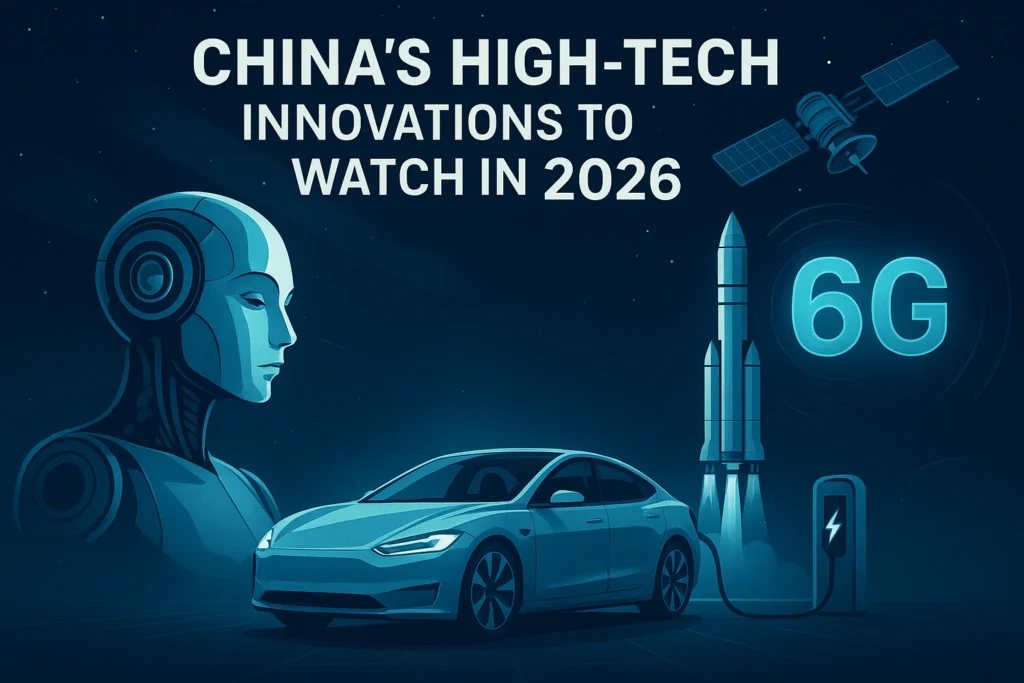By 2026, China is no longer just the “world’s factory.” It has evolved into a global hub of innovation, shaping industries from artificial intelligence to space exploration. While the U.S. and Europe continue to lead in many areas, China’s rapid technological growth is impossible to ignore. Whether it’s AI-powered cities, electric vehicles, next-gen semiconductors, or 6G networks, the country is positioning itself as a frontrunner in the technologies that will define the next decade.
In this article, we’ll explore the most important Chinese tech innovations in 2026, what they mean for global markets, and why they matter to everyday consumers in Tier 1 countries like the U.S., Canada, and the EU.
Artificial Intelligence
Artificial Intelligence (AI) is at the core of China’s 2026 innovation strategy.
- Smart City Projects: Multiple cities, including Shenzhen and Hangzhou, are running AI-powered traffic management, public safety, and environmental monitoring systems. These reduce congestion, improve emergency response, and cut emissions.
- AI in Healthcare: Hospitals are increasingly using AI diagnostic tools for early cancer detection, heart disease screening, and personalized treatment recommendations.
- Everyday Consumer AI: From voice assistants to AI-powered translation devices, Chinese companies like iFlytek and Baidu are shipping products globally, rivaling Amazon’s Alexa and Google’s AI offerings.
Why it matters: For the U.S. and Europe, China’s advancements mean more affordable consumer devices and potential competition in AI policy and governance.
Electric Vehicles (EVs) & Clean Energy Leadership
China is the world’s largest EV market, and 2026 is a turning point.
- BYD, NIO, and Xpeng have introduced EVs that combine longer ranges (600+ miles per charge) with faster charging times (under 15 minutes).
- Battery Tech: Solid-state batteries are rolling out, offering higher safety and energy density.
- Exports: Chinese EVs are entering U.S. and European markets at competitive prices, raising both excitement among consumers and concerns among regulators.
- Clean Energy Integration: Solar and wind power projects across China are feeding directly into charging infrastructure, making EVs greener than ever.
Why it matters: Affordable EVs from China may accelerate EV adoption worldwide, even as U.S. and European automakers race to keep pace.
Semiconductors
Semiconductors are the backbone of modern technology, and for years China depended heavily on imports. By 2026:
- Domestic Chip Production: Companies like SMIC have narrowed the gap, producing chips at 5nm and experimenting with 3nm.
- Supply Chain Security: With geopolitical tensions high, China is investing billions into reducing reliance on U.S. and Taiwanese technology.
- AI Chips: Specialized processors designed for AI workloads are gaining traction, helping power China’s growing AI ecosystem.
Why it matters: A stronger semiconductor industry makes China less vulnerable to sanctions and reshapes the global supply chain, affecting tech prices worldwide.
Robotics & Automation
From factory floors to family kitchens, China is doubling down on robotics.
- Industrial Robots: Adoption in manufacturing is at an all-time high, automating everything from electronics assembly to food packaging.
- Service Robots: Hotels, restaurants, and airports are now staffed with robots that deliver food, guide travelers, and handle check-ins.
- Home Robotics: Consumer robots for cleaning, cooking assistance, and elder care are being marketed aggressively in Tier 1 countries.
Why it matters: Automation in China could influence global labor trends, pushing other countries to accelerate their own adoption of robotics.
Space Exploration
China’s space ambitions are bigger than ever in 2026.
- Lunar Base Plans: The China National Space Administration (CNSA) is collaborating with international partners to build a semi-permanent lunar base.
- Mars Missions: A new rover mission is planned to drill deeper into Martian soil for water and biosignatures.
- Satellite Networks: China’s answer to Starlink, a massive satellite constellation, is expanding global internet coverage.
Why it matters: Space exploration is not just about prestige; it drives innovation in materials science, telecommunications, and renewable energy, areas that benefit consumers globally.
6G Technology
While many regions are still rolling out 5G, China is already preparing for 6G networks.
- Faster Speeds: 6G promises download speeds 100 times faster than 5G, enabling real-time VR/AR, holographic communication, and advanced IoT ecosystems.
- Global Trials: China’s major telecom companies, alongside research universities, are conducting trials set to roll out in the late 2020s.
Why it matters: 6G development will shape the next generation of industries from healthcare to entertainment, and China is racing to set global standards.
Consumer Gadgets & Lifestyle Tech
China’s consumer tech ecosystem remains one of the fastest-moving in the world. In 2026, expect:
- Wearables: Smart glasses with AR capabilities, health monitoring, and real-time translation.
- Smart Home Devices: Affordable, AI-powered appliances designed for international export.
- Wellness Tech: Air quality monitors, sleep-tracking devices, and smart fitness equipment are growing in popularity globally.
Why it matters: These gadgets often launch in China first, then hit U.S. and European markets at lower prices, shaping global consumer expectations.
Global Impact
China’s rise in 2026 isn’t just about local progress, it affects global economies, supply chains, and consumer access to technology.
- Competition: U.S. companies face stiffer competition in AI, EVs, and telecommunications.
- Collaboration: International universities and startups are partnering with Chinese companies for research.
- Regulation: Countries are scrambling to update trade and cybersecurity policies in response to Chinese innovation.
Conclusion
By 2026, China’s high-tech innovations are shaping the future of AI, EVs, semiconductors, space, and consumer technology. These advancements will not only transform China’s economy but will also reshape global markets and influence daily life across Tier 1 countries.
Whether you’re a student, investor, or tech enthusiast, keeping an eye on China’s progress isn’t optional, it’s essential.

